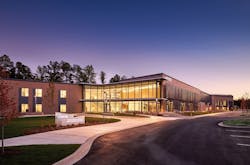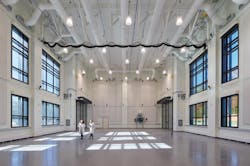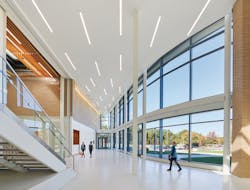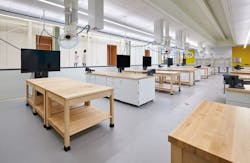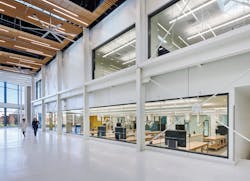The University System of Maryland at Southern Maryland’s new SMART Building completes
By David Malone, Managing Editor
The University System of Maryland at Southern Maryland (USMSM) has recently completed its newest building, the Southern Maryland Autonomous Research and Technology, or SMART, Building. The new 75,000-sf facility will help pioneer technology in the Unmanned Autonomous Systems (UAS) space.
Designed by Cooper Carry, the project is a cross between a traditional educational environment and a research institution that supports the development of high-tech autonomous machines capable of traveling by land, sea, or air. Cooper carry created a master plan for the complex oriented around a new campus quadrangle that replaced a former surface parking lot. The design allows users to easily traverse the facility and access varying research rooms.
The building features the Maryland Autonomous Technology Research and Innovation Xploration (MATRIX) Lab, which includes an 80’ by 60’ open-air land lab, an outdoor train lab for vehicle testing, augmented reality and virtual reality research space, a robotics lab, and a circulating water channel.
Also included are numerous maker spaces including a machining shop, a wood shop, 3D print labs, project assembly space, and an electronics shop for design and fabrication of autonomous vehicles. Students will have access to 16 flexible classroom spaces and engineering teaching labs equipped with laboratory equipment and state-of-the-art technology for enhanced learning.
“We designed a space that seamlessly connects the missions of students, faculty, researchers and STEM industries to prompt new avenues of innovation and create opportunities in autonomous science and artificial intelligence,” said Brent Amos, Principal in Cooper Carry’s Science + Technology Studio, in a release. “We were excited to incorporate amenities from both the non-science and science perspective, from public meeting spaces for colleagues and students to highly sophisticated lab spaces that allow cross-collaboration between distinct groups. Each of these elements helps create a truly functional research facility that sparks imagination and tangible solutions.”
Sustainability features include bioswales to manage and convey stormwater through natural systems, floor-to-ceiling windows, a building envelope designed to reduce energy consumption, enhanced indoor air quality, state-of-the-art lighting and electrical systems, and biophilic design principles that connect users to the natural environment. Perforated metal screens on the south and west facades provide shading and protection from harsh sun conditions while still allowing daylight and views from interior spaces.
The project has received LEED Gold certification.
